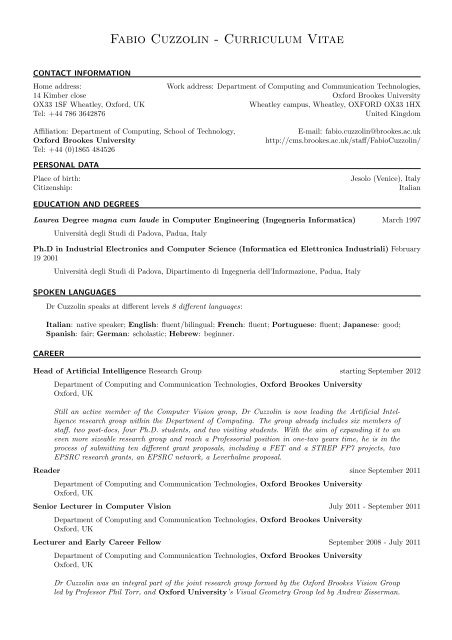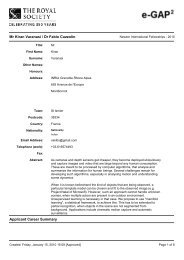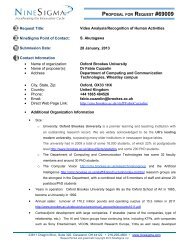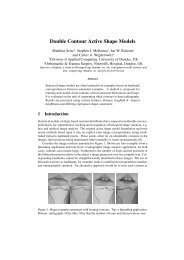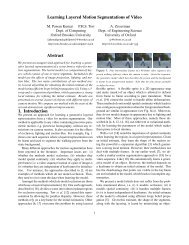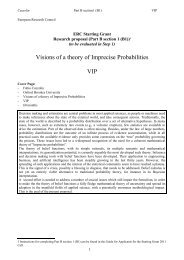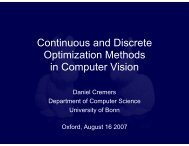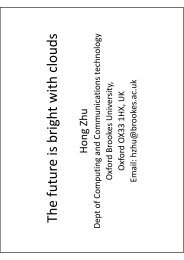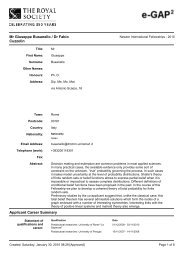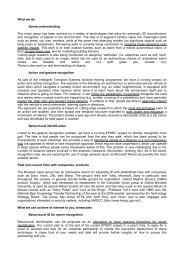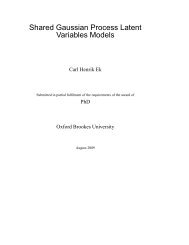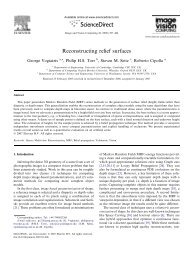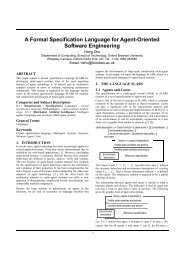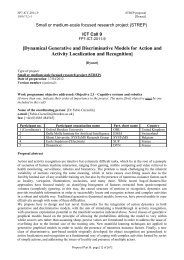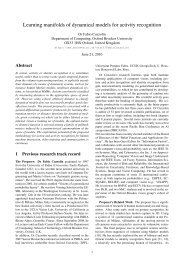Fabio Cuzzolin - Curriculum Vitae - CMS - Oxford Brookes University
Fabio Cuzzolin - Curriculum Vitae - CMS - Oxford Brookes University
Fabio Cuzzolin - Curriculum Vitae - CMS - Oxford Brookes University
Create successful ePaper yourself
Turn your PDF publications into a flip-book with our unique Google optimized e-Paper software.
CONTACT INFORMATION<br />
<strong>Fabio</strong> <strong>Cuzzolin</strong> - <strong>Curriculum</strong> <strong>Vitae</strong><br />
Home address: Work address: Department of Computing and Communication Technologies,<br />
14 Kimber close <strong>Oxford</strong> <strong>Brookes</strong> <strong>University</strong><br />
OX33 1SF Wheatley, <strong>Oxford</strong>, UK Wheatley campus, Wheatley, OXFORD OX33 1HX<br />
Tel: +44 786 3642876 United Kingdom<br />
Affiliation: Department of Computing, School of Technology, E-mail: fabio.cuzzolin@brookes.ac.uk<br />
<strong>Oxford</strong> <strong>Brookes</strong> <strong>University</strong> http://cms.brookes.ac.uk/staff/<strong>Fabio</strong><strong>Cuzzolin</strong>/<br />
Tel: +44 (0)1865 484526<br />
PERSONAL DATA<br />
Place of birth: Jesolo (Venice), Italy<br />
Citizenship: Italian<br />
EDUCATION AND DEGREES<br />
Laurea Degree magna cum laude in Computer Engineering (Ingegneria Informatica) March 1997<br />
Università degli Studi di Padova, Padua, Italy<br />
Ph.D in Industrial Electronics and Computer Science (Informatica ed Elettronica Industriali) February<br />
19 2001<br />
Università degli Studi di Padova, Dipartimento di Ingegneria dell’Informazione, Padua, Italy<br />
SPOKEN LANGUAGES<br />
Dr <strong>Cuzzolin</strong> speaks at different levels 8 different languages:<br />
Italian: native speaker; English: fluent/bilingual; French: fluent; Portuguese: fluent; Japanese: good;<br />
Spanish: fair; German: scholastic; Hebrew: beginner.<br />
CAREER<br />
Head of Artificial Intelligence Research Group starting September 2012<br />
Department of Computing and Communication Technologies, <strong>Oxford</strong> <strong>Brookes</strong> <strong>University</strong><br />
<strong>Oxford</strong>, UK<br />
Still an active member of the Computer Vision group, Dr <strong>Cuzzolin</strong> is now leading the Artificial Intelligence<br />
research group within the Department of Computing. The group already includes six members of<br />
staff, two post-docs, four Ph.D. students, and two visiting students. With the aim of expanding it to an<br />
even more sizeable research group and reach a Professorial position in one-two years time, he is in the<br />
process of submitting ten different grant proposals, including a FET and a STREP FP7 projects, two<br />
EPSRC research grants, an EPSRC network, a Leverhulme proposal.<br />
Reader since September 2011<br />
Department of Computing and Communication Technologies, <strong>Oxford</strong> <strong>Brookes</strong> <strong>University</strong><br />
<strong>Oxford</strong>, UK<br />
Senior Lecturer in Computer Vision July 2011 - September 2011<br />
Department of Computing and Communication Technologies, <strong>Oxford</strong> <strong>Brookes</strong> <strong>University</strong><br />
<strong>Oxford</strong>, UK<br />
Lecturer and Early Career Fellow September 2008 - July 2011<br />
Department of Computing and Communication Technologies, <strong>Oxford</strong> <strong>Brookes</strong> <strong>University</strong><br />
<strong>Oxford</strong>, UK<br />
Dr <strong>Cuzzolin</strong> was an integral part of the joint research group formed by the <strong>Oxford</strong> <strong>Brookes</strong> Vision Group<br />
led by Professor Phil Torr, and <strong>Oxford</strong> <strong>University</strong>’s Visual Geometry Group led by Andrew Zisserman.
The group is known as one of world’s best and has won an incredible number of awards in the past:<br />
http://cms.brookes.ac.uk/computing/groups.php?code=cvm.<br />
Short-listed for a faculty position by Robert Gordon <strong>University</strong>, Aberdeen, UK June 2008<br />
Ranked second in the 2007 Senior Researcher (Chargèe de Recherche de Premiere Classe, CR1) recruitment at INRIA<br />
- IRISA Rennes May 2007<br />
Marie Curie fellow September 2006 - September 2008<br />
Perception group, INRIA - Institut National de Recherche en Informatique et en Automatique<br />
Grenoble, France<br />
INRIA is the French National Institute for Computer Science and Automation, a world class institution<br />
whose research centers of Grenoble - Rhone Alpes and Nice - Sophia Antipolis have a very strong<br />
international reputation in machine vision. Dr <strong>Cuzzolin</strong> worked in the Perception group led by Dr Horaud.<br />
Offered a four-year fellowship by: Universitat Pompeu Fabra, Barcelona May 2006<br />
Offered postdoctoral jobs by: the Georgia Institute of Technology; the <strong>University</strong> of California at San Diego;<br />
the <strong>University</strong> of Houston June 2006<br />
Post-doctoral researcher October 2004 - April 2006<br />
Computer Science Department, <strong>University</strong> of California at Los Angeles<br />
Los Angeles, CA, USA<br />
UCLA is part of the <strong>University</strong> of California system, and is one of the top 25 US universities. The<br />
Computer Science Department and the Math Sciences department enroll academics of the level of Judea<br />
Pearl and Terrence Tao.<br />
Dr <strong>Cuzzolin</strong> worked as a post-doc in the UCLA Vision Lab led by Professor Stefano Soatto.<br />
Fixed-term Assistant Professor (Giovane ricercatore) January 2003 - December 2004<br />
Dipartimento di Elettronica e Informazione, Politecnico di Milano<br />
Milan, Italy<br />
Politecnico di Milano is universally recognized as the top university in the country, and ranks in the<br />
top 50 in the world for engineering. Dr <strong>Cuzzolin</strong> served as fixed-term Assistant Professor in the Image<br />
and Sound Processing Group led by Professor Stefano Tubaro.<br />
Post-doctoral researcher May 2001 - June 2003<br />
Dipartimento di Ingegneria dell’Informazione, Università degli Studi di Padova<br />
Padua, Italy<br />
The <strong>University</strong> of Padua ( Universitas Studii Paduani, founded 1222) is the seventh most ancient university<br />
in the world. It is currently one of the top three in Italy. Dr <strong>Cuzzolin</strong> received his Ph.D. there, and<br />
worked as a post-doc in the university’s Control Theory group.<br />
Visiting Scholar June 2000 - December 2000<br />
ESSRL - Electronic Systems and Signals Research Laboratory, Washington <strong>University</strong> in St Louis<br />
St. Louis, MO, USA<br />
The Washington <strong>University</strong> in St Louis is currently 12th in the US universities ranking. His medical<br />
school is the best in the country. Dr <strong>Cuzzolin</strong> conducted research there as a Visiting Scholar in the<br />
ESSRL laboratory for six months.<br />
In addition, Dr <strong>Cuzzolin</strong>:<br />
• had interviews for postdoctoral positions with <strong>Oxford</strong> <strong>University</strong>, Robotics group (October 2005); EPFL,<br />
Ecole Polytechnique Federale de Lausanne - IDIAP Laboratory, Martigny, Switzerland (April 2006);<br />
• had interviews for senior researcher positions with/offers from: Honeywell Labs - Minneapolis (June 2006);<br />
Riya - Mountain View, CA (June 2006);
AWARDS<br />
• Next 10 Award October 2012<br />
<strong>Oxford</strong> <strong>Brookes</strong> <strong>University</strong> - Faculty of Technology, Design and Environment<br />
Research accelerator programme, awarded to the three top emerging researchers in the Faculty<br />
• Outstanding Reviewer Award September 2012<br />
British Machine Vision Conference (BMVC 2012), <strong>University</strong> of Surrey, Guildford, UK<br />
• Short-listed for the Best Paper Award at BMVC 2012, with the paper “Learning discriminative space-time<br />
actions from weakly labelled videos” September 2012<br />
• Best Poster Prize July 2012<br />
“Learning discriminative space-time actions from weakly labelled videos”<br />
INRIA Visual Recognition and Machine Learning Summer School, Grenoble, France (200 partecipants)<br />
http://www.di.ens.fr/willow/events/cvml2012/<br />
• Best Poster Award July 2011<br />
“Geometric conditional belief functions in the belief space”<br />
International Symposium on Imprecise Probabilities - Theories and Applications, Innsbruck, Austria<br />
• Short-listed for the Best Paper Award at ECSQARU 2011, with the paper “On consistent approximations of<br />
belief functions in the mass space” June 2011<br />
• Best Paper Award December 2008<br />
“Alternative formulations of the theory of evidence based on basic plausibility and commonality assignments”<br />
Pacific Rim International Conference on Artificial Intelligence, Hanoi, Vietnam<br />
• Marie Curie fellowship September 2006 - September 2008<br />
MEMBERSHIPS OF SOCIETIES AND EDITORIAL BOARDS<br />
• Associate Editor of the:<br />
IEEE Transactions on Systems, Man, and Cybernetics - Part C since January 2011<br />
• Guest Editor for: Information Fusion Journal<br />
Special issue on “Information fusion applications to human health and safety” 2009-2012<br />
• Member of the Board of Directors of the:<br />
Belief Functions and Applications Society: www.ensieta.fr/bfas/ since 2010<br />
• Member of the Society for Imprecise Probabilities and Their Applications (SIPTA): www.sipta.org<br />
ORGANIZATION OF INTERNATIONAL CONFERENCES<br />
Dr <strong>Cuzzolin</strong> will be the Chair and local organizer of the upcoming 3rd International Conference on the<br />
Theory of Belief Functions (BELIEF 2014), to be held in <strong>Oxford</strong>, UK. Provisional dates: July 2014.<br />
OTHER COLLABORATIONS WITH JOURNALS<br />
Dr <strong>Cuzzolin</strong> regularly collaborates as a reviewer for the following international journals on Uncertainty Theory, Artificial<br />
Intelligence, and Computer Vision:<br />
• Artificial Intelligence<br />
• IEEE Transactions on Systems, Man, and Cybernetics - part B;<br />
• IEEE Transactions on Fuzzy Systems;<br />
• IEEE Transactions on Pattern Analysis and Machine Intelligence;<br />
• International Journal of Computer Vision;
• International Journal on Approximate Reasoning;<br />
• Computer Vision and Image Understanding;<br />
• Information Sciences;<br />
• Journal of Risk and Reliability;<br />
• International Journal on Uncertainty, Fuzziness, and Knowledge-Based Systems;<br />
• Image and Vision Computing;<br />
• Annals of Operations Research.<br />
MEMBERSHIPS IN PROGRAM COMMITTEES OF INTERNATIONAL CONFERENCES<br />
Dr <strong>Cuzzolin</strong> has served in the Technical Program Committee of 31 international conferences, such as:<br />
• Co-organizer of WPMSIIP 2011 - Fourth International Workshop on Principles and Methods of Statistical<br />
Inference with Interval Probability<br />
• IHMSC 2011, IHMSC 2012 - International Conference on Intelligent Human-Machine Systems and Cybernetics<br />
• IUKM2011, IUKM2013 - International Symposium on Integrated Uncertainty in Knowledge Modeling and<br />
Decision Making<br />
• ISIPTA 2009, ISIPTA 2011, ISIPTA 2013 - International Symposium on Imprecise Probabilities and Their<br />
Applications<br />
• ECSQARU 2009, ECSQARU 2011, ECSQARU 2013 - European Conference on Symbolic and Quantitative<br />
Approaches to Reasoning with Uncertainty<br />
• BELIEF 2010, BELIEF 2012 - The International Conference on the Theory of Belief Functions<br />
• IUM2010 - International Symposium on Integrated Uncertainty Management and Applications<br />
• FLAIRS 2008-2013 - Uncertain Reasoning track of the 21st, 22nd, 23rd, 24th, 25th and 26th International<br />
Florida Artificial Intelligence Research Society Conferences<br />
• ISAIM 2008 - 10th International Symposium on Artificial Intelligence and Mathematics (session chair)<br />
• IMMERSCOM 2007 - 2nd International Conference on Immersive Telecommunications<br />
• VISAPP 2006-2013 - International Conference on Computer Vision Theory and Applications<br />
He also serves as a reviewer for top vision conferences such as:<br />
• BMVC’10, BMVC’11, BMVC’12 - the British Machine Vision Conference<br />
• ECCV’10 - the European Conference on Computer Vision<br />
• ICCV’11 - the International Conference on Computer Vision<br />
SCIENTIFIC PROFILE<br />
Education and Career<br />
Dr <strong>Fabio</strong> <strong>Cuzzolin</strong> has a broad international experience, as he worked as a researcher in six world-class institutions<br />
of four different countries on both sides of the Atlantic.<br />
He graduated in 1997 from the <strong>University</strong> of Padua (Universitas Studii Paduani, founded 1222, is the seventh<br />
most ancient university in the world) with a laurea magna cum laude in Computer Engineering. He was awarded a<br />
Ph.D. by the same institution in 2001 for a thesis entitled “Visions of a generalized probability theory”.<br />
During his doctoral term he was Visiting Scholar in the ESSRL laboratory of the Washington <strong>University</strong> in St. Louis<br />
(12th in the US universities ranking, 2009).<br />
He was later appointed fixed-term Assistant Professor by Politecnico di Milano, Milan, Italy, consistently recognized<br />
as Italy’s top university.<br />
He later moved as a Postdoctoral Fellow to the UCLA Vision Lab, <strong>University</strong> of California at Los Angeles (24th<br />
in the US ranking). In 2006 he was offered a four-year appointment by Universitat Pompeu Fabra, Barcelona, and<br />
postdoctoral positions by UCSD, GeorgiaTech, U. Houston.
In the same year he was awarded a Marie Curie Fellowship in partnership with INRIA Rhone-Alpes, Grenoble,<br />
France.<br />
In 2007 he classified second in the 2007 Senior Researcher (CR1) national recruitment at INRIA, while in<br />
2008 he was short-listed for a faculty position at Robert Gordon <strong>University</strong>.<br />
From September 2008 to August 2011 he has been a Lecturer and Early Career Fellow in the Department of Computing,<br />
School of Technology of <strong>Oxford</strong> <strong>Brookes</strong> <strong>University</strong>, <strong>Oxford</strong>, U.K. He has been offered a Senior Lectureship by the<br />
same institution in July 2011. He is a Reader there since October 2011, and is taking up the post of Head of the<br />
Machine Learning Group.<br />
Dr <strong>Cuzzolin</strong> is also an integral part of the joint <strong>Oxford</strong> <strong>University</strong> - <strong>Oxford</strong> <strong>Brookes</strong> research group formed<br />
by the <strong>Oxford</strong> <strong>Brookes</strong> Vision Group led by Professor Phil Torr, and <strong>Oxford</strong> <strong>University</strong>’s Visual Geometry Group led<br />
by Professor Andrew Zisserman. The group is well known as one of world’s best and has won an incredible number of<br />
awards in the recent past.<br />
In addition, Dr <strong>Cuzzolin</strong> had interviews in the past with <strong>Oxford</strong> <strong>University</strong>, EPFL, Universitat Pompeu Fabra,<br />
UCSD, GeorgiaTech, U. Houston, Honeywell Labs, Riya.<br />
Research Interests<br />
Dr <strong>Cuzzolin</strong>’s research interests are mainly in artificial intelligence and approximate reasoning (including<br />
subjective probability, belief revision, knowledge representation, decision making), with a focus on imprecise (nonadditive)<br />
probabilities, but span also fields such as computer vision and machine learning.<br />
He is a recognized prominent expert in the field of belief functions, and a member of the Board of<br />
Directors of the Belief Functions and Applications Society. He formulated a geometric approach to uncertainty<br />
measures in which probabilities, possibilities and belief functions can all be represented as points of a Cartesian space<br />
and there analyzed, and worked extensively on the mathematical foundations of belief calculus.<br />
Within computer vision, his work focuses mainly on machine learning techniques for human motion analysis.<br />
He has been proposing the use of tensorial models for identity recognition from gait, new techniques for learning<br />
distances between dynamical models for action recognition, and explored spectral embedding techniques for unsupervised<br />
3D segmentation and matching of articulated objects such as the human body.<br />
In machine learning his work mainly concerns large scale manifold learning, in particular manifolds of linear dynamical<br />
models, and the integration of compressed sensing with training set-based non-linear embeddings.<br />
Publication Record<br />
Dr <strong>Cuzzolin</strong>’s top papers have been all rated four star or 3*/4* by mock REF panels of both external and<br />
internal reviewers.<br />
He is author at the present time of 74 peer-reviewed publications, published or under review. He is first or sole<br />
author of 63 such publications. Of these, 40 have been published in the last five years alone. He is single author<br />
of 2 book chapters, 19 journal papers (8 u/r), and 9 chapters in book series.<br />
Five additional journal papers are in the process of being submitted by the end of 2012.<br />
One of his papers won the best paper award at the PRICAI’08 symposium; another one was short-listed for<br />
best paper at the last ECSQARU’11 conference. He was the recipient of a best poster award at the ISIPTA’11<br />
symposium on Imprecise Probabilities, while he and his Ph.D. student Michael Sapienza received a poster prize<br />
at the last INRIA 2012 Summer School on Machine Learning and Visual Recognition. Their joint work was also<br />
short-listed for best paper at BMVC’12, where Dr <strong>Cuzzolin</strong> received the Outstanding Reviewer Award.<br />
Dr <strong>Cuzzolin</strong>’s research monograph collecting his work on the geometry of uncertainty measures is under review<br />
by Springer-Verlag.<br />
Membership of Boards, TCPs<br />
Dr <strong>Cuzzolin</strong> currently serves as an Associate Editor for the “IEEE Transactions on Systems, Man, and<br />
Cybernetics - Part C”, and Guest Editor for “Information Fusion”.<br />
He collaborates as a reviewer with several other journals in both computer vision and imprecise probabilities, such as:<br />
Artificial Intelligence, the IEEE Transactions on Systems, Man, and Cybernetics - part B, the IEEE Transactions on<br />
Fuzzy Systems, the International Journal on Approximate Reasoning, Computer Vision and Image Understanding,<br />
Information Sciences, the Journal of Risk and Reliability; the International Journal on Uncertainty, Fuzziness, and<br />
Knowledge-Based Systems, Image and Vision Computing, the Annals of Operations Research.<br />
He has served in the Program Committee of some 30 international conferences, and serves as a reviewer in<br />
top vision conferences such as BMVC, ECCV and ICCV.
Teaching and Supervision<br />
Dr <strong>Cuzzolin</strong> has an extensive teaching experience at university level in three different countries, first as a T.A.<br />
in Padua and Milan, later as a T.A. at UCLA, and eventually as the Module Leader for a number of honours courses at<br />
<strong>Oxford</strong> <strong>Brookes</strong> <strong>University</strong>, UK. At <strong>Brookes</strong> he has supervised several Master’s students’ final year dissertations.<br />
He regularly mentors a number of undergraduate students as their Academic Adviser.<br />
He is now in the process of organizing an entire Master’s course in Computer Vision together with the head of<br />
department Nigel Crook.<br />
He is just hired one Ph.D. student (start date September 2011) in the context of <strong>Brookes</strong>’ Intelligent Transport<br />
Systems doctoral training programme.<br />
One postdoctoral researcher under his supervision will be hired in 2012 as a result of his recent successful EPSRC<br />
application. One additional postdoc will be hired in case his current Leverhulme full proposal is funded.<br />
In addition, Dr <strong>Cuzzolin</strong> is actively involved in the co-supervision of a number of PhD students within the<br />
<strong>Oxford</strong> <strong>Brookes</strong> Vision Group led by Professor Philip Torr.<br />
At INRIA he has been informally mentoring another Ph.D. student, Diana Mateus, who graduated in 2008 with an<br />
excellent thesis on “Spectral Tools for Unsupervised Modelling of Articulated Objects from Multiple-view Videos”.<br />
He has been external assessor for a Ph.D. thesis at Politecnico di Milano.<br />
Network of academic contacts<br />
Dr <strong>Cuzzolin</strong> enjoys personal contacts with eminent academics in several scientific communities, ranging from<br />
computer vision (A. Zisserman (<strong>Oxford</strong>), P. Perona (Caltech), R. Cipolla (Cambridge)) and information theory and<br />
decision (S. Mitter (MIT)), to imprecise probabilities and statistics (G. Shafer (Rutgers), A. Dempster (Harvard), T.<br />
Seidenfeld (CMU)) and combinatorics (J. Oxley (Melbourne), J. Hirshfeld (Brighton)).<br />
Grants and Awards<br />
Dr <strong>Cuzzolin</strong> was awarded in 2011 a 122K pound EPSRC First Grant, for a project entitled “Tensorial modeling<br />
of dynamical systems for gait and activity recognition”. The project, which involves hiring a postdoc in Year 2, has<br />
received maximum marks by all four reviewers, and started in August 2011.<br />
His recent internal proposal for a Ph.D. studentship in “Multi Sensor Fusion for Simultaneous Localization and<br />
Mapping on Autonomous Vehicles” was also funded under the “Intelligent Transport Systems” School doctoral training<br />
programme.<br />
His 2011 Leverhulme Trust Project Grant application “The total probability theorem for finite random sets” reached<br />
the last full proposal stage (acceptance rate around 50%-60%), but was eventually not funded.<br />
At European level, in October 2010 he had applied for a 1.5 million euro ERC Starting Grant, with a proposal<br />
entitled “Visions of a theory of Imprecise Probabilities”, which was judged above the thresholds but not funded.<br />
In January 2011 Dr <strong>Cuzzolin</strong> submitted to FP7 Call 7 as the Coordinator and Principal Investigator a 2 million euro<br />
STREP on “Action and gesture recognition by imprecise-probabilistic graphical models” with IDSIA (Switzerland),<br />
Universiteit Gent (Belgium) and March Networks (Milan) as partners. This was later revised and submitted to Call 9<br />
as a 3-million-euro STREP with the title “Dynamical Generative and Discriminative Models for Action and Activity<br />
Localization and Recognition” and a different, stronger consortium. The proposal is still pending.<br />
At European level he is also now finalizing, again as the Coordinator, a Short Proposal for a Future and Emerging<br />
Technology (FET-Open) FP7 EU grant on “Large scale hybrid manifold learning” with INRIA (France), U.<br />
Pompeu Fabra (Spain) and Technion (Israel) as partners.<br />
At national level Dr <strong>Cuzzolin</strong> is currently setting up an EPSRC Network “NUTS: A Network on Uncertainty<br />
Theories” on inference and decision making under uncertainty together with Prof. J. Lawry (U. Bristol), Prof. J-B.<br />
Yang (Manchester Metropolitan), Prof. Frank Coolen (Durham), Prof. Jim Hall (<strong>Oxford</strong> <strong>University</strong>), Dr. W. Liu (U.<br />
Belfast) and many others.<br />
He is submitting at the same time two separate EPSRC Project Grant proposals, for a 300K pound project entitled<br />
“The total probability theorem for belief functions” on the development of a fully fledged theory of uncertainty, and a<br />
600K pound project on “Locating and recognizing complex activities via dynamic generative/discriminative modeling”<br />
in collaboration with his Co-Investigator professor Philip Torr.<br />
Finally, he is also submitting a Leverhulme Project Grant application on “Guessing plots for video googling” with<br />
<strong>Oxford</strong> <strong>University</strong>’s professor Lukasiewicz as Co-Investigator.<br />
PAST SCIENTIFIC ACTIVITY<br />
Lecturer and Early Career Fellow, <strong>Oxford</strong> <strong>Brookes</strong> - <strong>Oxford</strong> <strong>University</strong>, <strong>Oxford</strong>, UK September 2008 - now<br />
My reputation in the field of imprecise probabilities comes from the formulation of a geometric approach<br />
to uncertainty measures in which probabilities, possibilities and random sets can all be represented as
points of a Cartesian space and there analyzed.<br />
My work concerns, however, all mathematical properties of non-additive probabilities in terms of their<br />
algebra and geometry, and the combinatorial foundations of the theory. My ambition is to fill the current<br />
gaps in the theory of non-additive probabilities, in order to propose it to a wide audience of practitioners<br />
as a viable alternative to standard probabilistic reasoning. I am particularly interested in the generalization<br />
of the total probability theorem to random sets and belief functions. I have also contributed to the<br />
problem of transforming belief functions into probability measures or possibilities for decision making and<br />
efficient implementation of the belief calculus.<br />
With Professor Torr and the Vision Group we are working on a machine learning project which concerns<br />
the application of support vector machines to large scale classification problems, via randomized<br />
projections.<br />
Marie Curie fellow, INRIA Rhone-Alpes, Grenoble, France September 2006 - September 2008<br />
PERCEPTION project<br />
At INRIA Rhone-Alpes I collaborated with Radu Horaud and Edmond Boyer on two different projects.<br />
On one side we developed a technique based on non-linear reduction (locally linear embedding) for robust<br />
segmentation of human bodyparts through clustering in an embedding space, relying on the stability<br />
of the emebedded manifold. On the other hand, we worked on a general framework for maximal subgraph<br />
matching using spectral techniques, in which nodes of two graphs are associated by matching the<br />
eigenfunctions of the related Laplacian matrices. The method can be applied to dense voxelset matching<br />
of two widely separated poses of an articulated object, even under changes of topology.<br />
Post-doctoral researcher, <strong>University</strong> of California at Los Angeles, California October 2004 - April 2006<br />
UCLA Vision Lab<br />
As a post-doc in the Vision Lab I worked on two distinct lines of research.<br />
In vision we considered the problem of human identification from gait (humanID), focusing on the issue<br />
of finding an effective view-invariant approach. Given a dataset of image sequences in which different<br />
people walking normally are seen from several well-separated views, we learned bilinear models to classify<br />
the identity of a known person from a view not included in the available training set.<br />
In machine learning, we considered the problem of classifying motions encoded as dynamical models of a<br />
certain class, by finding a suitable distance function in the space of such models. We studied a supervised<br />
differential-geometric method for learning a Riemannian metric for a given class of dynamical models,<br />
by selecting this distance among a family of pullback metrics induced by the Fisher information tensor<br />
through a parameterized diffeomorphism.<br />
Fixed-term Assistant Professor (Giovane ricercatore), Politecnico di Milano, January 2003 - December 2004<br />
ISPG - Image and Sound Processing Group<br />
In Milan I was in charge of the group’s activities in the VICOM (Virtual Immersive Communications)<br />
project. We focused on the design of what are called in the literature “smart rooms”, developing a new<br />
approach based on multi-camera systems for tracking people in indoor environments and interpreting their<br />
motions or actions through adequate stochastic models. We investigated the use of volumetric representations<br />
which can naturally solve critical problems such as viewpoint dependence, irrelevant variations of<br />
the body’s trajectory, or occlusions due to the presence of other objects in the scene.<br />
Ph.D. student, Università degli Studi di Padova March 1998 - March 2001<br />
Autonomous Navigation and Computer Vision Laboratory - NAVLAB<br />
Ph.D. Thesis: “Visions of a generalized probability theory”<br />
Supervisor: Prof. Ruggero Frezza<br />
As I mentioned above, my doctoral research was dedicated to the study of the theory of finite random sets<br />
or theory of evidence. The theory was introduced in the late Seventies by Glenn Shafer as an alternative<br />
mathematical description of uncertainty, starting from a series of seminal works by Arthur Dempster.<br />
In this formalism uncertainty is represented by non-additive probability measures called belief functions,<br />
which assign belief values to sets of possibilities rather than single events.<br />
I developed a geometric approach to belief functions (and uncertainty measures in general, including<br />
probabilities, possibilities, and fuzzy sets) in which measures are represented as points of a Cartesian<br />
space. Different classes of uncertainty measures can be studied there, their distance measured to look<br />
for probability or possibility approximations of belief functions. Starting from the intuition provided by<br />
vision problems such as data association and object tracking I explored the links between probability,<br />
geometry and combinatorics, along a path that led to new insights in both fields.
Post-doctoral researcher, Università degli Studi di Padova May 2001 - June 2003<br />
During my postdoc in Padua I kept working on the completion and extension of the theory of belief<br />
functions, in particular on the introduction of the analogous of probabilistic notions such as filtering,<br />
total probability, random process. The greater complexity of belief functions when compared to classical<br />
probability measures induces a richer structure that deserves to be analyzed. In particular I compared<br />
the notion of independence in subjective probability with its definition in matroid and lattice theory, and<br />
started tackling the total belief theorem as the natural generalization of the total probability theorem for<br />
belief functions.<br />
Visiting Researcher, Washington <strong>University</strong> in St. Louis, St. Louis, Missouri June- July 2000<br />
ESSRL - Electronic Systems and Signals Research Laboratory<br />
In collaboration with Stefano Soatto, at the time Assistant Professor at WashU, I focused on the unsupervised<br />
action recognition problem, i.e. the automatic detection of a certain action category in an image<br />
sequence (like for instance switching on a TV, entering a room, etc.) without any training phase driven<br />
by human agents. In particular, we conducted a study of HMM clustering with respect to superposition<br />
of different actions in the same scene.<br />
Master thesis, Università degli Studi di Padova October 1996 - March 1997<br />
Autonomous Navigation and Computer Vision Laboratory (NAVLAB)<br />
Thesis: “Automatic Gesture Recognition”<br />
Supervisor: Prof. Ruggero Frezza<br />
The goal of the thesis was designing and implementing an automatic gesture recognition system. At the<br />
time we were among the first people to adopt a finite state - continuous observation hidden Markov model<br />
to encode the motion as a sequence of a small number of postures. An experiment was implemented in<br />
which a small radio controlled vehicle was guided by means of a small number of gestures.<br />
RESEARCH GRANT PROPOSALS as a Principal Investigator.<br />
Electronic copies of my grant proposals can be found on my web page:<br />
http://cms.brookes.ac.uk/staff/<strong>Fabio</strong><strong>Cuzzolin</strong>/.<br />
Awarded<br />
<strong>Oxford</strong> <strong>Brookes</strong> <strong>University</strong> - Central university funding<br />
Uncertainty in Computer Vision<br />
Duration: 12 months. Budget: 3000 pounds.<br />
<strong>Oxford</strong> <strong>Brookes</strong> <strong>University</strong>)<br />
“Intelligent Transport Systems” doctoral training programme<br />
Multi Sensor Fusion for Simultaneous Localization and Mapping on Autonomous Vehicles<br />
Ph.D. Studentship. Supervisors: Dr <strong>Fabio</strong> <strong>Cuzzolin</strong> and Prof Philip Torr. Duration: 3 years.<br />
Start date: September 2011.<br />
Engineering and Physical Sciences Research Council (EPSRC)<br />
First Grant Scheme<br />
Tensorial modeling of dynamical systems for gait and activity recognition<br />
Duration: 2 years. Budget: 122000 pounds. Rated 6/6, 6/6, 5/6, 6/6. Start date: July 24 2011.<br />
<strong>Oxford</strong> <strong>Brookes</strong> <strong>University</strong>)<br />
Faculty of Technology, Design and Environment<br />
Next 10 Programme Award<br />
Research accelerator programme, designed to help the top emerging researchers in the Faculty to<br />
progress towards professorial status and a leadership position within their discipline. Involves a<br />
Ph.D. Studentship. Start date: October 2012.
Pending<br />
Magna International<br />
Action recognition plus scene interpretation in a smart vehicle scenario<br />
Responsible for the Machine Learning and Vision parts of a Faculty-wide negotiation.<br />
Duration: 3 years. Budget: to be established<br />
Status: submitted October 2012.<br />
Engineering and Physical Sciences Research Council (EPSRC)<br />
Collaborative project<br />
Making action recognition work in the real world<br />
Co-applicant: Professor Philip Torr.<br />
Duration: 3 years. Budget: 600K pounds.<br />
Status: submitted October 2012.<br />
European Union<br />
7th Framework Programme - Call 9<br />
Dynamical Generative and Discriminative Models for Action and Activity Localization and<br />
Recognition<br />
Recent submissions<br />
Duration: 3 years. Budget: 3 million euros. Submitted Call 9, April 17 2012.<br />
Partners: <strong>Oxford</strong> <strong>Brookes</strong> U. (coordinator), Professor Gert de Cooman, Universiteit Gent (Belgium);<br />
Dr A. Antonucci, IDSIA (Lugano, Switzerland); SUPELEC (Paris, France); Dynamixyz (Rennes,<br />
France).<br />
Leverhulme Trust<br />
Research Projects Grants<br />
The total probability theorem for belief functions<br />
In preparation<br />
Duration: 36 months. Budget: 121781 pounds.<br />
Status: outline stage passed, full proposal invited, not funded at last stage.<br />
Leverhulme Trust<br />
Research Projects Grants<br />
Guessing plots for video googling<br />
Duration: 24 months. Budget: 200K pounds. Co-applicant: Professor Thomas Lukasiewicz (<strong>Oxford</strong><br />
<strong>University</strong>).<br />
Status: outline proposal to be submitted October 2012.<br />
Medical Research Council (MRC)<br />
Methodology Research Programme<br />
Monitoring mental conditions at home via Kinect<br />
Duration: 3 years (in preparation). Budget: to be established.<br />
Status: to submit January 29 2013.<br />
Engineering and Physical Sciences Research Council (EPSRC)<br />
Research Grant<br />
The total probability theorem for belief functions<br />
Duration: 3 years (in preparation). Budget: 300K pounds.<br />
Status: Case for support ready, costing in progress. To submit Fall 2012.<br />
European Union<br />
7th Framework Programme - FET-Open (Future Emerging Technologies)<br />
Large scale hybrid manifold learning<br />
Duration: 3 years. Budget: 2 millions euros.<br />
Partners: <strong>Oxford</strong> <strong>Brookes</strong> U. (coordinator); Dr R. Horaud (INRIA Rhone-Alpes, France); Dr A.<br />
Frangi (Universitat Pompeu Fabra, Barcelona); Dr M. Bronstein (IDSIA, Switzerland).<br />
Status: revising FET short proposal submission.
Engineering and Physical Sciences Research Council (EPSRC)<br />
Collaborative project<br />
NUTS: A Network on Uncertainty Theories<br />
Duration: 3 years. Budget: 80K pounds. Provisional deadline: December 2012.<br />
Partners: Professor Jonathan Lawry (U. Bristol); Professor Jian-Bo Yang (Manchester Metropolitan<br />
<strong>University</strong>); Dr Weiru Liu (U. Belfast); Professor Frank Coolen (U. Durham); Professor Jim Hall<br />
(<strong>Oxford</strong> <strong>University</strong>), Professor Thomas Lukasiewicz (<strong>Oxford</strong> <strong>University</strong>), Professor Anthony Hunter<br />
(UCL).<br />
Status: Drafting case for support.<br />
RESEARCH GRANT PROPOSALS as a Partner.<br />
In preparation<br />
Engineering and Physical Sciences Research Council (EPSRC)<br />
Collaborative project<br />
EPSRC Network in Sparse Representations and Compressed Sensing<br />
Coordinator: Mark Plumbley, Queen Mary <strong>University</strong> of London.<br />
Duration: 3 years. Budget: to be decided. Provisional deadline: End 2012.<br />
OTHER RESEARCH PROJECTS Dr <strong>Cuzzolin</strong> was involved in<br />
Politecnico di Milano<br />
FIRB - VICOM, Virtual Immersive Communications, Ministry of <strong>University</strong> and Scientific Research - 2003-5.<br />
In Milan my post was funded by the national project VICOM, and one of my duties was to assist the head of<br />
the group professor Tubaro in the organization of meetings and the redaction of deliverables.<br />
INRIA Rhone-alpes<br />
VISIONTRAIN, European project, network of excellence in computer vision.<br />
As coordinators of the project we were in charge of organizing all periodic meetings and prepare final and<br />
intermediate reports.<br />
COORDINATION OF MASTER’S PROGRAMMES<br />
Dr <strong>Cuzzolin</strong> has been nominated Subject Coordinator for the new Master’s course in Computer Vision<br />
which will be launched in September 2013 by the Department of Computing, <strong>Oxford</strong> <strong>Brookes</strong> <strong>University</strong>.<br />
TEACHING EXPERIENCE<br />
Dr <strong>Cuzzolin</strong> has an extensive teaching experience at university level in three different countries, first as a teaching<br />
assistant in Padua and Milan, later as a T.A. at UCLA, and eventually as the Module Leader for a number of honours<br />
courses at <strong>Oxford</strong> <strong>Brookes</strong>.<br />
Teaching assistant, “Controllo dei Processi” (autonomous navigation)<br />
Held by Prof. Ruggero Frezza, Department of Information Engineering, <strong>University</strong> of Padova.<br />
Academic years 1999-2000, 2001-2002.<br />
Teaching assistant, “Identificazione dei Modelli e Analisi dei Dati” (parameter identification and statistics)<br />
Held by Prof. Ruggero Frezza, Environmental engineering, <strong>University</strong> of Padova.<br />
Academic years 1999-2000, 2000-2001.<br />
C.I.S.A.S. Master - “Corso di Perfezionamento in Sistemi Spaziali” (advanced course on space systems),<br />
Interdipartimental Center for Space Studies (CISAS), <strong>University</strong> of Padova.<br />
June 24-28, 2002.<br />
Teaching assistant, “Comunicazioni Elettriche” (electric communications)<br />
Held by Prof. Stefano Tubaro, Politecnico di Milano.<br />
Academic year 2002-2003.
Teaching assistant, “Computer Science 268: Machine Perception”<br />
Held by Prof. Stefano Soatto, UCLA.<br />
Fall 2005.<br />
Module leader, “Machine Vision”<br />
Honours course, <strong>Oxford</strong> <strong>Brookes</strong> <strong>University</strong><br />
Semester 2 2008-09. Semester 1 2009-12.<br />
Module leader, “Advanced Artificial Intelligence”<br />
Honours course, <strong>Oxford</strong> <strong>Brookes</strong> <strong>University</strong><br />
Semester 2 2009-12.<br />
Lecturer and Module leader, “Image Technology”<br />
<strong>Oxford</strong> <strong>Brookes</strong> <strong>University</strong><br />
Semesters 1-2 2008-12.<br />
MEMBERSHIPS OF SCHOOL COMMITTEES AND PANELS<br />
• Semestral combined computing fields examination committee (SEC), <strong>Oxford</strong> <strong>Brookes</strong> <strong>University</strong>;<br />
• Interview panels for a Lectureship/Senior Lectureship in Media Technology, <strong>Oxford</strong> <strong>Brookes</strong>, 2009 and for two<br />
postdoctoral positions in the computer vision group (2010, 2011);<br />
• <strong>Oxford</strong> <strong>Brookes</strong>’ Academic Progression Initiative (API) meeting;<br />
• Preliminary Research Excellence Framework (REF) meetings, <strong>Oxford</strong> <strong>Brookes</strong> <strong>University</strong>, 2010-11;<br />
• Internal Assessor for the Ph.D. thesis ”High Order Inference for Vision Problems”, by Chris Russell, July 2011;<br />
SUPERVISION OF MASTER’S AND PHD STUDENTS, POSTDOCS<br />
Postdoctoral researchers<br />
Wenjuan Gong<br />
Ph.D. students<br />
Postdoc - <strong>Oxford</strong> <strong>Brookes</strong> <strong>University</strong>, UK<br />
Topic: “Tensorial modeling of dynamical systems for gait and activity recognition”<br />
Funded by EPSRC First Grant. Starting November 5 2012<br />
Micheal Sapienza<br />
Ph.D. student - <strong>Oxford</strong> <strong>Brookes</strong> <strong>University</strong>, UK<br />
Topic: “Intelligent Transport Systems” - Started October 2011<br />
John Twycross<br />
Ph.D. student - <strong>Oxford</strong> <strong>Brookes</strong> <strong>University</strong>, UK<br />
Topic: “Actors style analysis and synthesis in movies” - To start Fall 2012<br />
under recruitment<br />
Visiting students<br />
Ph.D. student - <strong>Oxford</strong> <strong>Brookes</strong> <strong>University</strong>, UK<br />
Topic: “The total belief theorem”<br />
Funded by Next 10 Award - To start Fall 2012<br />
Rania Kallel<br />
Visiting MSc student from IHEC Carthage, Tunisia<br />
February - May 2013
Rocco de Rosa<br />
Master’s students<br />
Visiting Ph.D. student from <strong>University</strong> of Milan, Italy<br />
September 2013 - March 2014<br />
Laurent Simon<br />
MsC. student - <strong>Oxford</strong> <strong>Brookes</strong> <strong>University</strong>, UK<br />
Dissertation title: “Tensor modeling for gait recognition” - 2009<br />
Thomas Coville<br />
MsC. student - <strong>Oxford</strong> <strong>Brookes</strong> <strong>University</strong>, UK<br />
Dissertation title: “UML Touch: Design and Implementation of a free-hand UML designer for<br />
Tablet PC using sketch recognition in C#.” - 2010<br />
Dan Williams<br />
MsC. student - <strong>Oxford</strong> <strong>Brookes</strong> <strong>University</strong>, UK<br />
Dissertation title: “Artificial intelligence algorithms for PACMAN programming” - 2010<br />
Deepak Sharma<br />
MsC. student - <strong>Oxford</strong> <strong>Brookes</strong> <strong>University</strong>, UK<br />
Dissertation title: “SpyCam, Video Surveillance System” - 2010<br />
Brad Lishman<br />
INVITED TALKS<br />
MsC. student - <strong>Oxford</strong> <strong>Brookes</strong> <strong>University</strong>, UK<br />
Dissertation title: “Creation of a neural network based trading system for the foreign exchange<br />
market” - 2012<br />
• Coherent Laplacian 3D Protrusion Segmentation<br />
British Machine Vision Association - Articulated Human Motion technical meeting, 23 October 2009<br />
RECENT SEMINARS<br />
• Sequences of belief functions and data association, 3 a Scuola CIRA di Dottorato, Bertinoro (FO), Italy, July 20<br />
1999.<br />
• Evidential reasoning framework for object tracking, LIDS - Laboratory of Information and Decision Systems,<br />
MIT, Boston, MA, September 1999.<br />
• Visioni di una teoria delle probabilità generalizzate (in Italian), Department of Information Engineering, <strong>University</strong><br />
of Padova, March 8 2001.<br />
• Visioni di una teoria delle probabilità generalizzate (in Italian), Dipartimento di Informatica, Cà Foscari <strong>University</strong><br />
in Venice, September 26, 2001.<br />
• Computer vision applications of generalized probabilities (in Italian), Departmental workshop, Department of<br />
Information Engineering, <strong>University</strong> of Padova. Vicenza, June 11-12, 2002.<br />
• Alcuni aspetti della teoria delle probabilità generalizzate (in Italian), Politecnico di Milano, September 16, 2002<br />
• Machine learning and imprecise probabilities for computer vision, EPFL - Istituto Dalle Molle, Martigny, Switzerland,<br />
April 2006<br />
• Machine learning and imprecise probabilities for computer vision, Universitat Pompeu Fabra, Barcelona, Spain,<br />
April 26 2006<br />
• Machine learning methods and imprecise probabilities for computer vision, INRIA Rhone-Alpes, Grenoble,<br />
France, May 4 2006<br />
• Machine learning and imprecise probabilities for computer vision, Georgia Institute of Technology, Atlanta,<br />
USA, June 22 2006
• Bilinear models and Riemannian metrics for motion classification, Microsoft Research Europe, Machine Learning<br />
and Perception Group, Cambridge, UK, July 11 2006<br />
• Machine learning, imprecise probabilities, and computer vision, SequeL team, INRIA Futurs, Lille, France,<br />
February 6 2007<br />
• Robust spectral 3D-bodypart segmentation along time, IRISA, Rennes, France, May 2 2007<br />
• A geometric approach to uncertainty, Department of Mathematical Sciences, <strong>University</strong> of Durham, UK, November<br />
25 2008<br />
• Coherent Laplacian 3D protrusion segmentation, Department of Computing, <strong>Oxford</strong> <strong>Brookes</strong> <strong>University</strong>, UK,<br />
January 21 2009<br />
• Bilinear models for gait ID, Department of Computing, <strong>Oxford</strong> <strong>Brookes</strong> <strong>University</strong>, UK, January 24 2009<br />
• A geometric approach to uncertainty, Department of Engineering Mathematics, <strong>University</strong> of Bristol, UK, March<br />
12 2009<br />
• Coherent Laplacian 3D protrusion segmentation, Queen Mary - <strong>University</strong> of London, UK, December 2009<br />
• Learning pullback action manifolds, <strong>University</strong> of Surrey, Guildford, UK, April 28th 2010<br />
• Learning pullback action manifolds, Heriot-Watt <strong>University</strong>, Edinburgh, UK, May 26th 2010<br />
• Geometric conditional belief functions, Manchester Metropolitan <strong>University</strong>, UK, July 7th 2010<br />
PUBLICATIONS<br />
Dr <strong>Fabio</strong> <strong>Cuzzolin</strong> is author at the present time of 74 peer-reviewed publications, published or under review.<br />
He is first or single author of 64 such publications. Of these, 40 have been published in the last five years<br />
alone. He is single author of 2 book chapters, 19 journal papers (8 u/r), and 9 chapters in book series.<br />
In addition, 5 more journal articles are in the process of being submitted in the next few months.<br />
One of his papers won the best paper award at the PRICAI’08 symposium; another one was short-listed for<br />
best paper at the last ECSQARU’11 conference. He was the recipient of a best poster award at the ISIPTA’11<br />
symposium on Imprecise Probabilities, while he and his Ph.D. student Michael Sapienza received a poster prize<br />
at the last INRIA 2012 Summer School on Machine Learning and Visual Recognition. Their first joint work was<br />
short-listed for best paper at BMVC 2012.<br />
Finally, Dr <strong>Cuzzolin</strong>’s research monograph collecting his work on the geometry of uncertainty measures in under<br />
review with Springer-Verlag.<br />
Dr <strong>Cuzzolin</strong>’s best papers have been all rated *4 star* by the latest mock REF panel.<br />
All the publications listed below are accessible as PDF files at the following URL:<br />
http://cms.brookes.ac.uk/staff/<strong>Fabio</strong><strong>Cuzzolin</strong>/pubs.html<br />
Figure 1: Total publications in the last 5 years.
Monographs<br />
Under review<br />
1. <strong>Fabio</strong> <strong>Cuzzolin</strong>, The geometry of uncertainty, submitted to Springer-Verlag, Berlin, 2012<br />
Book Chapters<br />
Published<br />
2. <strong>Fabio</strong> <strong>Cuzzolin</strong>, Manifold learning for multi-dimensional auto-regressive dynamical models, in “Machine Learning<br />
for Vision-based Motion Analysis”, Advances in Pattern Recognition, Part 1, pages 55-74, L. Wang, G. Zhao,<br />
L. Cheng, M. Pietikäine (Eds.), Springer, 2011<br />
3. <strong>Fabio</strong> <strong>Cuzzolin</strong>, Multilinear modeling for robust identity recognition from gait, in “Behavioral Biometrics for<br />
Human Identification: Intelligent Applications”, pages 169-188, Liang Wang and Xin Geng (Eds.), IGI, 2010<br />
Under review<br />
4. <strong>Fabio</strong> <strong>Cuzzolin</strong>, An algebraic study of the notion of independence of frames, submitted to “Mathematics of<br />
Uncertainty Modeling in the Analysis of Engineering and Science Problems” ,IGI Publishing, October 10 2012<br />
Journal papers<br />
Published<br />
5. <strong>Fabio</strong> <strong>Cuzzolin</strong>, On the fiber bundle structure of the space of belief functions<br />
accepted by the Annals of Combinatorics (I.F. 0.703), July 2012<br />
6. <strong>Fabio</strong> <strong>Cuzzolin</strong>, On the relative belief transform<br />
International Journal of Approximate Reasoning (I.F. 2.09), 53(5), pages 786-804, July 2012<br />
7. Al Ozonoff, <strong>Fabio</strong> <strong>Cuzzolin</strong> and Paul Snow,<br />
Guest editorial: Special issue on information fusion applications to human health and safety<br />
Information Fusion (I.F. 1.40), 13(2), April 2012<br />
8. <strong>Fabio</strong> <strong>Cuzzolin</strong>, Three alternative combinatorial formulations of the theory of evidence<br />
Intelligent Data Analysis (I.F. 0.929), 14(4), pages 439-464, December 2010<br />
9. <strong>Fabio</strong> <strong>Cuzzolin</strong>, Geometry of relative plausibility and relative belief of singletons<br />
Annals of Mathematics and Artificial Intelligence (I.F. 0.893), 59(1), pages 47-79, May 2010<br />
10. <strong>Fabio</strong> <strong>Cuzzolin</strong>, The geometry of consonant belief functions: simplicial complexes of necessity measures<br />
Fuzzy Sets and Systems (I.F. 2.138), 161(10), pages 1459-1479, 16 May 2010<br />
11. <strong>Fabio</strong> <strong>Cuzzolin</strong>, Credal semantics of Bayesian transformations in terms of probability intervals<br />
IEEE Transaction on Systems, Man, and Cybernetics - part B (I.F. 3.08), 40(2), pages 421-432, April 2010<br />
12. <strong>Fabio</strong> <strong>Cuzzolin</strong>, A geometric approach to the theory of evidence<br />
IEEE Transactions on Systems, Man, and Cybernetics - part C (I.F. 2.01), 38(4), pages 522-534, 2008<br />
13. <strong>Fabio</strong> <strong>Cuzzolin</strong>, Two new Bayesian approximations of belief functions based on convex geometry<br />
IEEE Transactions on Systems, Man, and Cybernetics - part B (I.F. 3.08), 37(4), pages 993-1008, 2007<br />
14. <strong>Fabio</strong> <strong>Cuzzolin</strong>, Algebraic structure of the families of compatible frames of discernment<br />
Ann. Math. Artif. Intell. (I.F. 0.893) 45(1-2), pages 241-274, 2005<br />
15. <strong>Fabio</strong> <strong>Cuzzolin</strong>, Geometry of Dempster’s rule of combination<br />
IEEE Transactions on Systems, Man, and Cybernetics - part B (I.F. 3.08), 34(2), pages 961- 977, 2004<br />
Under revision<br />
16. <strong>Fabio</strong> <strong>Cuzzolin</strong>, Lp consonant approximations of belief functions<br />
submitted to the the IEEE Transactions on Fuzzy Systems (I.F. 4.26), March 2011, revised December 2011,<br />
second revision July 2012, third revision October 2012<br />
17. <strong>Fabio</strong> <strong>Cuzzolin</strong> and Wenjuan Gong, A belief-theoretical approach to example-based pose estimation, submitted to<br />
the IEEE Transactions on Fuzzy Systems (I.F. 4.26), July 2012; reviews received October 2012, major revision<br />
under way, deadline December 3 2012
18. <strong>Fabio</strong> <strong>Cuzzolin</strong>, Learning pullback manifolds of generative dynamical models for action recognition, submitted<br />
to the IEEE Transactions on Pattern Analysis and Machine Intelligence (I.F. 4.91), July 2012; reviews received<br />
October 2012, major revision under way, deadline January 21 2013<br />
19. <strong>Fabio</strong> <strong>Cuzzolin</strong>, Betting with probability intervals: the intersection probability<br />
submitted to Artificial Intelligence (I.F. 2.38), February 2007, revised June 2009, to revise End 2012<br />
20. <strong>Fabio</strong> <strong>Cuzzolin</strong>, Consistent transformations of belief functions<br />
submitted to the International Journal of Approximate Reasoning (I.F. 2.09), December 2011, to revise End 2012<br />
21. Thomas Burger and <strong>Fabio</strong> <strong>Cuzzolin</strong>, Two k-additive generalizations of the pignistic transform for imprecise<br />
decision making, submitted to Fuzzy Sets and Systems (I.F. 2.138), October 2011, to revise End 2012<br />
22. <strong>Fabio</strong> <strong>Cuzzolin</strong>, Geometric conditioning in belief calculus<br />
submitted to Artificial Intelligence (I.F. 2.38), March 2011, to revise End 2012<br />
Under review<br />
23. <strong>Fabio</strong> <strong>Cuzzolin</strong>, Diana Mateus and Radu Horaud, Robust coherent Laplacian protrusion segmentation along 3D<br />
sequences, submitted to the International Journal on Computer Vision (I.F. 3.741), July 2012<br />
Currently in preparation<br />
• Michael Sapienza, <strong>Fabio</strong> <strong>Cuzzolin</strong> and Philip Torr, Learning constellations of discriminative space-time actions<br />
parts, invited to the BMVC 2012 Special Issue of the International Journal of Computer Vision (I.F. 3.741),<br />
deadline January 31 2013<br />
• <strong>Fabio</strong> <strong>Cuzzolin</strong>, Johan Schubert, Thierry Denoeux, Sebastien Destercke and Prakash P. Shenoy, Theory of belief<br />
functions - A review - Part I, invited by the Editor in Chief of the International Journal of Approximate<br />
Reasoning (I.F. 2.155), June 2013<br />
• <strong>Fabio</strong> <strong>Cuzzolin</strong>, Johan Schubert, Thierry Denoeux, Sebastien Destercke, Anne-Laure Jousselme and Rajendra<br />
Srivastava, Theory of belief functions - A review - Part II, invited by the Editor in Chief of the International<br />
Journal of Approximate Reasoning (I.F. 2.155), to submit June 2013<br />
• <strong>Fabio</strong> <strong>Cuzzolin</strong> and Thomas Burger, The geometry of the set of k-additive dominating belief functions, to submit<br />
to Information Sciences (I.F. 3), End 2012<br />
• Diana Mateus, Radu Horaud, <strong>Fabio</strong> <strong>Cuzzolin</strong>, David Knossow and Edmond Boyer, Spectral matching of dense<br />
voxel-sets by orthogonal alignment in an embedding space, to submit to the IEEE Transactions on Pattern<br />
Analysis and Machine Intelligence (I.F. 4.91), End 2012<br />
• Wenjuan Gong and <strong>Fabio</strong> <strong>Cuzzolin</strong>, Tensor modeling of dynamical systems for robust identity recognition from<br />
gait, to submit to the IEEE Transactions on Pattern Analysis and Machine Intelligence (I.F. 4.91), End 2012<br />
• <strong>Fabio</strong> <strong>Cuzzolin</strong>, The total belief theorem: restricted case, to submit to the Journal of the Royal Statistical Society<br />
- Part B (I.F. 3.47), End 2012<br />
Chapters in book series (in reverse chronological order)<br />
Published<br />
24. <strong>Fabio</strong> <strong>Cuzzolin</strong>, Complexes of outer consonant approximations, in “Symbolic and Quantitative Approaches to<br />
Reasoning with Uncertainty” (ECSQARU’09) 5 , Lecture Notes in Computer Science, Vol. 5590/2009, pages 275-<br />
286, Springer Berlin / Heidelberg, 2009<br />
25. <strong>Fabio</strong> <strong>Cuzzolin</strong>, The intersection probability and its properties, in “Symbolic and Quantitative Approaches to<br />
Reasoning with Uncertainty” (ECSQARU’09) 5 , Lecture Notes in Computer Science, Vol. 5590/2009, pages 287-<br />
298, Springer Berlin / Heidelberg, 2009<br />
26. <strong>Fabio</strong> <strong>Cuzzolin</strong>, Alternative formulations of the theory of evidence based on basic plausibility and commonality<br />
assignments 6 (long paper, best paper award recipient), in “PRICAI 2008: Trends in Artificial Intelligence”,<br />
Lecture Notes in Computer Science, Vol. 5351/2008, pages 91-102, Springer Berlin / Heidelberg, 2009<br />
27. <strong>Fabio</strong> <strong>Cuzzolin</strong>, Dual properties of the relative belief of singletons 6 (long paper), in “PRICAI 2008: Trends<br />
in Artificial Intelligence”, Lecture Notes in Computer Science, Vol. 5351/2008, pages 78-90, Springer Berlin /<br />
Heidelberg, 2009<br />
28. <strong>Fabio</strong> <strong>Cuzzolin</strong>, On the credal structure of consistent probabilities, in “Logics in Artificial Intelligence”, Lecture<br />
Notes in Computer Science, Volume 5293/2008, pages 126-139, Springer Berlin / Heidelberg, 2008.
29. <strong>Fabio</strong> <strong>Cuzzolin</strong>, A lattice-theoretic interpretation of independence on frames, in “Interval / Probabilistic Uncertainty<br />
and Non-classical Logics”, Advances in Soft Computing, Vol. 46, Huynh, V.-N.; Nakamori, Y.; Ono, H.;<br />
Lawry, J.; Kreinovich, V.; Nguyen, H.T. (Eds.), Springer-Verlag, Berlin - Heidelberg, 2008<br />
30. <strong>Fabio</strong> <strong>Cuzzolin</strong>, Semantics of the relative belief of singletons, in “Interval / Probabilistic Uncertainty and Nonclassical<br />
Logics”, Advances in Soft Computing, Vol. 46, Huynh, V.-N.; Nakamori, Y.; Ono, H.; Lawry, J.;<br />
Kreinovich, V.; Nguyen, H.T. (Eds.), Springer-Verlag, Berlin - Heidelberg, 2008<br />
31. <strong>Fabio</strong> <strong>Cuzzolin</strong>, Diana Mateus, Edmond Boyer, and Radu Horaud, Robust spectral 3D-bodypart segmentation<br />
in time, in “Human Motion - Understanding, Modeling, Capture and Animation”, Lecture Notes in Computer<br />
Science, Vol. 4814/2007, pages 196-211, Seidel, H.-P.; Wang, Y.; Rosenhahn, B.; Mori, G. (Eds.), Springer<br />
Berlin / Heidelberg, 2007<br />
32. <strong>Fabio</strong> <strong>Cuzzolin</strong>, On the orthogonal projection of a belief function, in “Symbolic and Quantitative Approaches<br />
to Reasoning with Uncertainty” (ECSQARU’07) 5 , Lecture Notes in Computer Science, Vol. 4724/2007, pages<br />
356-367, Springer Berlin / Heidelberg, 2007<br />
Peer-reviewed 1234 conference proceedings (in reverse chronological order)<br />
Published or Accepted<br />
33. Michael Sapienza, <strong>Fabio</strong> <strong>Cuzzolin</strong> and Philip Torr, Learning discriminative space-time actions from weakly<br />
labelled videos, Proceedings of the British Machine Vision Conference (BMVC’12), <strong>University</strong> of Sussex, UK,<br />
September 2012 (oral, shortlisted for major prizes)<br />
34. <strong>Fabio</strong> <strong>Cuzzolin</strong>, Consonant approximations in the belief space, Proceedings of the 2nd International Conference<br />
on Belief Functions (BELIEF’12), Compiègne, France (oral)<br />
35. <strong>Fabio</strong> <strong>Cuzzolin</strong>, Generalizations of the relative belief transform, Proceedings of the 2nd International Conference<br />
on Belief Functions (BELIEF’12), Compiègne, France (oral)<br />
36. <strong>Fabio</strong> <strong>Cuzzolin</strong>, Game-theoretical semantics of epistemic probability transformations, Proceedings of the 2nd<br />
International Conference on Belief Functions (BELIEF’12), Compiègne, France (oral)<br />
37. <strong>Fabio</strong> <strong>Cuzzolin</strong>, Lp consonant approximations of belief functions in the mass space, Proceedings of the International<br />
Symposium on Imprecise Probabilities and Their Applications (ISIPTA’11), Innsbruck, June 2011<br />
(shortlisted for best paper)<br />
38. <strong>Fabio</strong> <strong>Cuzzolin</strong>, On consistent approximations of belief functions in the mass space, Proceedings of the International<br />
Symposium on Symbolic and Quantitative Approaches to Reasoning with Uncertainty (ECSQARU’11),<br />
Belfast, June 2011<br />
39. Alessandro Antonucci and <strong>Fabio</strong> <strong>Cuzzolin</strong>, Credal Sets Approximation by Lower Probabilities: Application to<br />
Credal Networks, 13 th International Conference on Information Processing and Management of Uncertainty 2<br />
(IPMU’10), June 2010<br />
40. <strong>Fabio</strong> <strong>Cuzzolin</strong>, Geometric conditioning of belief functions, accepted by the First International Workshop on the<br />
Theory of Belief Functions, Brest, April 2010<br />
41. Thomas Burger and <strong>Fabio</strong> <strong>Cuzzolin</strong>, The barycenters of the k-additive dominating belief functions and the<br />
pignistic k-additive belief functions, accepted by the First International Workshop on the Theory of Belief<br />
Functions, Brest, April 2010<br />
42. <strong>Fabio</strong> <strong>Cuzzolin</strong>, Consistent approximations of belief functions, Proceedings of the International Symposium on<br />
Imprecise Probabilities and Their Applications 1 (ISIPTA’09), Durham, UK, July 14-18 2009;<br />
43. <strong>Fabio</strong> <strong>Cuzzolin</strong>, Credal semantics of Bayesian approximations, Proceedings of the International Symposium on<br />
Imprecise Probabilities and Their Applications 1 (ISIPTA’09), Durham, UK, July 14-18 2009;<br />
1<br />
The International Symposium on Imprecise Probabilities and Their Applications (ISIPTA) is the major conference venue<br />
in the field of imprecise probabilities. Papers are normally reviewed by three reviewers. Acceptance rate is around 30-40%.<br />
2<br />
The International Conference on Information Processing and Management of Uncertainty is a major European venue in<br />
Information Theory and Uncertainty.<br />
3<br />
The IEEE Conference on Decision and Control (CDC) is the major venue in the field of Control Theory.<br />
4<br />
IEEE International Conference on Computer Vision and Pattern Recognition (CVPR), the International Conference on<br />
Computer Vision (ICCV), and the European Conference on Computer Vision (ECCV) are the three major conferences in<br />
Computer Vision. Each paper is reviewed by three reviewers in double-blind format, and subject to the final decision of an area<br />
chair. Around 2000 papers are submitted each time. Some 50 (2.5%) are accepted as orals, 250 (12.5%) as posters.<br />
5<br />
ECSQARU is a major European venue in the field of uncertainty and logics. Papers are refereed by two or three reviewers.<br />
Acceptance rate is around 40%.<br />
6<br />
Accepted as Long Paper at PRICAI’08, acceptance rate 22%.
44. <strong>Fabio</strong> <strong>Cuzzolin</strong>, Learning pullback metrics for linear models, European Conference on Computer Vision 4 (ECCV’08),<br />
First workshop on Machine Learning for Vision-based Motion Analysis, Marseille, France, October 2008<br />
45. Diana Mateus, Radu Horaud, David Knossow, <strong>Fabio</strong> <strong>Cuzzolin</strong>, and Edmond Boyer, Articulated Shape Matching<br />
Using Laplacian Eigenfunctions and Unsupervised Point Registration, Proceedings of the IEEE International<br />
Conference on Computer Vision and Pattern Recognition 4 (CVPR’08), Anchorage, Alaska, June 2008;<br />
46. <strong>Fabio</strong> <strong>Cuzzolin</strong>, Diana Mateus, David Knossow, Edmond Boyer, and Radu Horaud, Coherent Laplacian protrusion<br />
segmentation, Proceedings of the IEEE International Conference on Computer Vision and Pattern<br />
Recognition 4 (CVPR’08), Anchorage, Alaska, June 2008;<br />
47. <strong>Fabio</strong> <strong>Cuzzolin</strong>, Boolean and matroidal independence in uncertainty theory, Proceedings of the 10th International<br />
Symposium on Mathematics and Artificial Intelligence (ISAIM’08), Fort Lauderdale, Florida, January 2-4 2008<br />
48. <strong>Fabio</strong> <strong>Cuzzolin</strong>, An interpretation of consistent belief functions in terms of simplicial complexes, Proceedings<br />
of the 10th International Symposium on Mathematics and Artificial Intelligence (ISAIM’08), Fort Lauderdale,<br />
Florida, January 2-4 2008<br />
49. Diana Mateus, <strong>Fabio</strong> <strong>Cuzzolin</strong>, Edmond Boyer and Radu Horaud, Articulated Shape Matching by Robust Alignment<br />
of Their Embedded Representations, International Conference on Computer Vision 4 (ICCV’07) - 3dRR<br />
Workshop, Rio de Janeiro, Brasil, October 20 2007<br />
50. Diana Mateus, <strong>Fabio</strong> <strong>Cuzzolin</strong>, Edmond Boyer, and Radu Horaud, Articulated Shape Matching Using Locally<br />
Linear Embedding and Orthogonal Alignment, International Conference on Computer Vision 4 (ICCV’07) - NTRL<br />
Workshop, Rio de Janeiro, October 14 2007<br />
51. <strong>Fabio</strong> <strong>Cuzzolin</strong>, Using Bilinear Models for View-invariant Action and Identity Recognition, Proceedings of the<br />
IEEE International Conference on Computer Vision and Pattern Recognition 4 (CVPR’06), pp. 1701-1708, New<br />
York, June 18-22 2006<br />
52. <strong>Fabio</strong> <strong>Cuzzolin</strong>, The geometry of relative plausibilities, 11 th International Conference on Information Processing<br />
and Management of Uncertainty 2 (IPMU’06), special session on “Fuzzy measures and integrals, capacities and<br />
games”, Paris, July 2006<br />
53. <strong>Fabio</strong> <strong>Cuzzolin</strong>, On the properties of relative plausibilities, Proceedings of the International Conference of the<br />
IEEE Systems, Man, and Cybernetics Society (SMC’05), vol.1, pp. 594-599, Hawaii, USA - October 10-12, 2005<br />
54. <strong>Fabio</strong> <strong>Cuzzolin</strong> and Ruggero Frezza, Evidential modeling for pose estimation, Proceedings of the 4th International<br />
Symposium on Imprecise Probabilities and Their Applications 1 (ISIPTA’05), Carnegie Mellon <strong>University</strong>,<br />
Pittsburgh, 2005<br />
55. Giambattista Gennari, Alessandro Chiuso, <strong>Fabio</strong> <strong>Cuzzolin</strong> and Ruggero Frezza Integration of shape constraints in<br />
data association filters, IEEE Conference on Decision and Control 3 (CDC’04), vol.3, pp. 2668- 2673, Bahamas,<br />
December 14-17, 2004<br />
56. <strong>Fabio</strong> <strong>Cuzzolin</strong>, Augusto Sarti and Stefano Tubaro, Action modeling with volumetric data, Proceedings of the<br />
2004 International Conference on Image Processing (ICIP’04), vol. 2, pp. 881- 884, Singapore, October 24-27,<br />
2004<br />
57. <strong>Fabio</strong> <strong>Cuzzolin</strong>, Augusto Sarti and Stefano Tubaro Invariant action classification with volumetric data, International<br />
Workshop on Multimedia Signal Processing, pp. 395-398, Siena, Italy, 9/29-10/1 2004<br />
58. <strong>Fabio</strong> <strong>Cuzzolin</strong>, Simplicial complexes of finite fuzzy sets, Proceedings of the International Conference on Information<br />
Processing and Management of Uncertainty 2 (IPMU’04), pp. 1733-1740 Perugia, Italy, July 4-9,<br />
2004<br />
59. <strong>Fabio</strong> <strong>Cuzzolin</strong>, Geometry of upper probabilities, Proceedings of the 3 nd International Symposium on Imprecise<br />
Probabilities and Their Applications 1 (ISIPTA’03), Lugano, Switzerland, July 14-17, 2003<br />
60. <strong>Fabio</strong> <strong>Cuzzolin</strong>, Ruggero Frezza, Alessandro Bissacco and Stefano Soatto, Towards unsupervised detection of<br />
actions in clutter, Proceedings of the 2002 Asilomar Conference on Signals, Systems, and Computers, vol.1, pp.<br />
463-467, Asilomar Conference Center in Pacific Grove, CA<br />
61. Giambattista Gennari, Alessandro Chiuso, <strong>Fabio</strong> <strong>Cuzzolin</strong> and Ruggero Frezza, Integrating shape and dynamic<br />
probabilistic models for data association and tracking, Proceedings of the IEEE 2002 Conference on Decision<br />
and Control 3 , The Venetian Hotel, Las Vegas, Nevada, December 10-13, 2002<br />
62. <strong>Fabio</strong> <strong>Cuzzolin</strong>, Geometry of Dempster’s rule, Special Session on Knowledge Representation under Vagueness<br />
and Uncertainty, 2002 International Conference on Fuzzy Systems and Knowledge Discovery (FSKD’02), Singapore,<br />
November 18-22, 2002
63. <strong>Fabio</strong> <strong>Cuzzolin</strong> and Ruggero Frezza, Lattice structure of the families of compatible frames of discernment, Proceedings<br />
of the 2 nd International Symposium on Imprecise Probabilities and Their Applications 1 (ISIPTA’01),<br />
Ithaca, NY, June 26-29, 2001<br />
64. <strong>Fabio</strong> <strong>Cuzzolin</strong> and Ruggero Frezza, Geometric analysis of belief space and conditional subspaces, Proceedings<br />
of the 2 nd International Symposium on Imprecise Probabilities and Their Applications 1 (ISIPTA’01), Ithaca,<br />
NY, June 26-29, 2001<br />
65. <strong>Fabio</strong> <strong>Cuzzolin</strong> and Ruggero Frezza, Integrating feature spaces for object tracking, Proceedings of the International<br />
Symposium on the Mathematical Theory of Networks and Systems (MTNS2000), Perpignan, France,<br />
June 21-25, 2000<br />
66. <strong>Fabio</strong> <strong>Cuzzolin</strong> and Ruggero Frezza, An evidential reasoning framework for object tracking, SPIE - Photonics<br />
East 99 - Telemanipulator and Telepresence Technologies VI (Matthew R. Stein, ed.), vol. 3840, pp. 13-24,<br />
September 19-22, 1999<br />
67. Andrea Sorrentino, <strong>Fabio</strong> <strong>Cuzzolin</strong> and Ruggero Frezza, Using hidden Markov models and dynamic size functions<br />
for gesture recognition, Proceedings of the 8th British Machine Vision Conference (BMVC97) (Adrian F. Clark,<br />
ed.), vol. 2, pp. 560-570, September 1997<br />
Under review<br />
68. <strong>Fabio</strong> <strong>Cuzzolin</strong>, Learning pullback HMM distances for action recognition, submitted to Face and Gesture Recognition<br />
(FG’13), Shanghai, China, September 2012<br />
In preparation<br />
• Michael Sapienza, <strong>Fabio</strong> <strong>Cuzzolin</strong> and Philip Torr, Part-based discriminative action models, to submit to<br />
CVPR’13, Portland, Oregon, November 2012<br />
• <strong>Fabio</strong> <strong>Cuzzolin</strong> and Michael Sapienza, Pullback distances for action recognition, to submit to ICCV’13, April<br />
2013<br />
• Michael Sapienza, <strong>Fabio</strong> <strong>Cuzzolin</strong> and Philip Torr, Learning constellations of discriminative action parts, to<br />
submit to ICCV’13, April 2013<br />
• Wenjuan Gong and <strong>Fabio</strong> <strong>Cuzzolin</strong>, Tensor modeling of dynamical models for gait identification, to submit to<br />
ICCV’13, April 2013<br />
• Rocco de Rosa, Alessandro Antonucci, Alessandro Giusti and <strong>Fabio</strong> <strong>Cuzzolin</strong>, Action Recognition by Similarity<br />
Measures for Hidden Markov Models, to submit to ICCV’13, April 2013<br />
• <strong>Fabio</strong> <strong>Cuzzolin</strong> and Thomas Burger, On the vertices of the set of k-additive dominating belief functions, to<br />
submit to ISIPTA’13, Compiegne, France, February 2013<br />
• <strong>Fabio</strong> <strong>Cuzzolin</strong>, Random set random forests, to submit to ISIPTA’13, Compiegne, France, February 2013<br />
• <strong>Fabio</strong> <strong>Cuzzolin</strong>, An empirical comparison of belief-theoretical, RVM- and Gaussian process based approaches to<br />
example-based pose estimation, to submit to ECSQARU’13, Utrecht, Netherlands, February 2013<br />
Oral and poster conference presentations<br />
Presented or accepted<br />
69. Michael Sapienza, <strong>Fabio</strong> <strong>Cuzzolin</strong> and Philip Torr, Learning discriminative space-time actions from weakly<br />
labelled videos (poster prize recipient), INRIA Machine Learning Summer School, Grenoble, July 2012<br />
70. <strong>Fabio</strong> <strong>Cuzzolin</strong>, Geometric conditional belief functions in the belief space (best poster award recipient),<br />
International Symposium on Imprecise Probabilities and Their Applications (ISIPTA’11), Innsbruck, June 2011<br />
71. <strong>Fabio</strong> <strong>Cuzzolin</strong>, On the relationship between the notions of independence in matroids, lattices, and Boolean<br />
algebras, 21 th British Combinatorial Conference (BCC’07), <strong>University</strong> of Reading, UK, July 8-13, 2007<br />
72. <strong>Fabio</strong> <strong>Cuzzolin</strong>, Lattice modularity and linear independence, 18 th British Combinatorial Conference (BCC’01),<br />
<strong>University</strong> of Sussex, Brighton, UK, July 1-6, 2001<br />
73. <strong>Fabio</strong> <strong>Cuzzolin</strong>, Families of compatible frames of discernment as semimodular lattices, International Conference<br />
of the Royal Statistical Society (RSS2000), Reading, UK, September 12-15, 2000<br />
74. <strong>Fabio</strong> <strong>Cuzzolin</strong> and Ruggero Frezza, Combining qualitative and quantitative models for motion reconstruction<br />
of articulated objects, Mathematical Theory of Networks and Systems (MTNS98), Padova, July 1998
Technical reports<br />
• <strong>Fabio</strong> <strong>Cuzzolin</strong>, Alessandro Bissacco, Ruggero Frezza and Stefano Soatto, Towards unsupervised detection of<br />
actions in clutter, Technical Report CSD-2000/33, Department of Computer Science, <strong>University</strong> of California<br />
at Los Angeles, Los Angeles, December 2000<br />
• <strong>Fabio</strong> <strong>Cuzzolin</strong> and Stefano Soatto, Using Bilinear Models for View-invariant Identity Recognition from Gait,<br />
UCLA Technical Report CSD-TR050007, March 17, 2005<br />
• <strong>Fabio</strong> <strong>Cuzzolin</strong> and Stefano Soatto, Using Bilinear Models for View-invariant Action and Identity Recognition,<br />
UCLA Technical Report CSD-TR050053, December 17, 2005<br />
• <strong>Fabio</strong> <strong>Cuzzolin</strong> and Stefano Soatto, Learning Riemannian Metrics for Classification of Dynamical Models, UCLA<br />
Technical Report CSD-TR050054, December 17, 2005<br />
Theses<br />
• <strong>Fabio</strong> <strong>Cuzzolin</strong>, Riconoscimento automatico dei gesti, (“Automatic gesture recognition”, in Italian), Master’s<br />
thesis, Università degli Studi di Padova, Italy, March 1997.<br />
• <strong>Fabio</strong> <strong>Cuzzolin</strong>, Vision of a generalized probability theory, Ph.D. dissertation, Università degli Studi di Padova,<br />
Italy, March 2001.<br />
Figure 2: Evolution of Google citations and indices from Sept 2010 to Sept 2012.<br />
GOOGLE SCHOLAR CITATION COUNT<br />
Total count (31/10/2012): 573 (top 3% in Computer Science over 900,000 world experts according to arnetminer.org).<br />
H-index (31/10/2012): 13 (top 1.5% in Computer Science).<br />
i10-index (31/10/2012): 15; G-index (16/10/2012): 21.<br />
Top papers by citation count:
1. Articulated Shape Matching Using Laplacian Eigenfunctions and Unsupervised ... (2008) 72<br />
2. A geometric approach to the theory of evidence (2008) 70 (62 + 6 + 2)<br />
3. Two new Bayesian approximations of belief functions based on convex geometry (2007) 46 ( 39 + 5 + 2)<br />
4. Geometry of upper probabilities (2003) 27 (24 + 3)<br />
5. Using bilinear models for view-invariant action and identity recognition (2006) 24 (23 + 1)<br />
6. Geometric analysis of belief space and conditional subspaces (2001) 23<br />
7. Geometry of Dempster’s rule of combination (2004) 21<br />
8. Articulated Shape Matching Using Locally Linear Embedding and Orthogonal Alignment (2007) 18 (12 + 6)<br />
9. Dual properties of relative belief of singletons (2008) 15<br />
10. Semantics of the relative belief of singletons (2008) 15<br />
11. Visions of a generalized probability theory (2001) 15<br />
12. The geometry of consonant belief functions: Simplicial complexes of necessity measures (2010) 13 (9 + 4)<br />
13. Rationale and properties of the intersection probability (u/r) 13 (8 + 5)<br />
14. Coherent Laplacian 3-D protrusion segmentation (2008) 12<br />
15. Geometric conditioning of belief functions (2010) 10<br />
16. Three alternative combinatorial formulations of the theory of evidence (2010) 9 (6 + 3)<br />
17. On the credal structure of consistent probabilities (2008) 9 (4 + 4 + 1)<br />
18. Evidential reasoning framework for object tracking (1999) 8<br />
19. Lp consistent approximations of belief functions / Metric consistent approximations ... (2011) 8 (7 + 1)<br />
20. Using hidden Markov models and dynamic size functions for gesture recognition (1997) 8 (5 + 3)<br />
21. Algebraic structure of the families of compatible frames of discernment (2005) 7<br />
22. Simplicial complexes of finite fuzzy sets (2004) 7<br />
23. Credal Sets Approximation by Lower Probabilities: Application to Credal Networks (2010) 7<br />
24. Credal semantics of Bayesian approximations in terms of probability intervals (2010) 7 (5 + 2)<br />
25. Geometry of relative plausibility and relative belief of singletons (2010) 7 (3 + 4)<br />
26. Lp consonant approximations of belief functions in the mass space (2011) 6 (3 + 3)<br />
PEOPLE I RECOMMENDED<br />
• Thomas Burger<br />
Maitre de Conference (Assistant Professor), Université de Bretagne Sud, Vannes, France<br />
• Chris Russell<br />
Post-doc, Queen Mary <strong>University</strong> of London, UK<br />
• Massimo Nespolo<br />
Post-doc, CERN - Centre European de Recherches Nuclaires, Geneva, Switzerland<br />
• Giuseppe Busanello<br />
Post-doc, Università La Sapienza, Rome, Italy<br />
• Kiran Varanasi<br />
Post-doc, Max Planck Institute, Saarbrucken, Germany<br />
• Ramya Narasimha<br />
Ph.D., INRIA Rhone-Alpes, Grenoble, France<br />
• Davide Onofrio<br />
Ph.D., Politecnico di Milano, Italy
• Massimiliano Pierobon<br />
Ph.D. Student, Georgia Institute of Technology, Atlanta, USA<br />
• Guillaume Arnaud<br />
Ph.D. Student, Louisiana State <strong>University</strong>, Baton Rouge, USA<br />
• Hermann Kahn<br />
Ph.D. applicant, <strong>University</strong> College London, UK<br />
LIST OF REFEREES<br />
In reverse chronological order.<br />
• Glenn Shafer<br />
Full Professor, Department of Accounting and Information Systems<br />
Rutgers Business School<br />
180 <strong>University</strong> Avenue, Newark, New Jersey 07102, USA<br />
Phone: +1 973 3531604, Fax +1 973 3531283<br />
gshafer@andromeda.rutgers.edu<br />
• Philip H. S. Torr<br />
Professor<br />
School of Technology, <strong>Oxford</strong> <strong>Brookes</strong> <strong>University</strong><br />
Phone: 01865 484592<br />
philiptorr@brookes.ac.uk<br />
• Jim Hall<br />
Professor of Climate and Environmental Risks<br />
<strong>Oxford</strong> <strong>University</strong><br />
Centre for the Environment, South Parks Road, <strong>Oxford</strong> OX1 3QY<br />
Phone: +44 (0)1865 275846<br />
jim.hall@eci.ox.ac.uk<br />
• Frank Coolen<br />
Professor<br />
Department of Mathematical Sciences, Durham <strong>University</strong><br />
Science Laboratories, South Road Durham, DH1 3LE, United Kingdom<br />
Phone: +44 (0)191 334 3048<br />
Frank.Coolen@durham.ac.uk<br />
• Stefano Soatto<br />
Full professor<br />
Computer Science Department, <strong>University</strong> of California at Los Angeles<br />
Boelter Hall 3531d, Los Angeles (CA) 90095-1596<br />
Phone: +1 310 8254840<br />
soatto@cs.ucla.edu<br />
• Jonathan Lawry<br />
Head of Department<br />
Department of Engineering Mathematics, Bristol <strong>University</strong><br />
Queen’s Building, <strong>University</strong> Walk, Bristol BS8 1TR, United Kingdom<br />
Phone: +44 (0)117 331 5629<br />
j.lawry@bristol.ac.uk<br />
• Teddy Seidenfeld<br />
Professor of Statistics, Department of Philosophy<br />
Baker Hall 135J, Carnegie Mellon <strong>University</strong>, Pittsburgh (PA) 15213-3890, USA<br />
Phone: +1 412 2682209<br />
teddy@stat.cmu.edu<br />
• Radu Horaud<br />
Directeur de Recherche de premiere classe<br />
INRIA Rhone-Alpes<br />
655, avenue de l’Europe, 38334 SAINT ISMIER CEDEX, France<br />
Phone: +33 476 61 52 26<br />
Radu.Horaud@inrialpes.fr
• David Duce<br />
Professor of Computer Science<br />
Department of Computing, School of Technology, <strong>Oxford</strong> <strong>Brookes</strong> <strong>University</strong><br />
Wheatley campus, OX33 1HX, <strong>Oxford</strong> UK<br />
daduce@brookes.ac.uk<br />
• William F. Clocksin<br />
Head of Department<br />
School of Computer Science, <strong>University</strong> of Hertfordshire<br />
College Lane, Hatfield AL10 9AB, UK<br />
wfc@clocksin.com<br />
• Alejandro Frangi<br />
Departement de Tecnologia<br />
Universitat Pompeu Fabra<br />
Pg de Circunvalación 8, E0800 Barcelona, Spain<br />
Phone: +34 93 542 1451<br />
alejandro.frangi@upf.edu<br />
• Stefano Tubaro<br />
Full professor<br />
Dipartimento di Elettronica e Informazione, Politecnico di Milano<br />
Piazza Leonardo da Vinci 32, 20133 Milano, Italy<br />
Phone: +39 02 23993647<br />
tubaro@elet.polimi.it<br />
• Paul Snow<br />
Independent consultant in statistics and database<br />
P.O. Box 6134 Concord, NH 03303-6134<br />
Phone: + 1 603 753 1011<br />
paulsnow@verizon.net<br />
• Gert de Cooman<br />
SYSTeMS Research Group<br />
Universiteit Gent, Technologiepark - Zwijnaarde 914, 9052 Zwijnaarde Belgium<br />
Phone: +32 (0)9 2645653<br />
gert.decooman@ugent.be<br />
<strong>Oxford</strong>, UK, November 2012<br />
<strong>Fabio</strong> <strong>Cuzzolin</strong>


